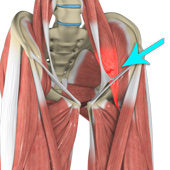What is a Hip Flexor Strain?
A hip flexor strain is an overuse injury to the flexor muscles of your hip and can range from a minor stretch injury to a complete tear of the muscle fibers or tendons.

The hip flexors are several muscles that allow the flexion movement (bending) of your hip and include the following:
- Psoas major muscle
- Iliacus muscle
- Rectus femoris muscle
- Pectineus muscle
- Sartorius muscle
The severity of a hip flexor strain can grade as follows:
- Grade 1 tear: A few muscle fibers are damaged
- Grade 2 tear: Damage to significant muscle fibers with moderate loss of muscle function
- Grade 3 tear: The muscles are torn or ruptured completely and you usually can’t walk without a limp
Causes
The common causes of a hip flexor strain include:
- A fall or a slip
- A sudden blow to the hip flexor muscles
- Too much exercise in a short time
- Activities involving repetitive movements such as cycling, jumping, dancing, martial arts, and football
Symptoms
You may experience a tearing or popping sound when the injury occurs. Common symptoms include:
- Pain while stretching your leg or bending towards your torso
- Muscle spasms at the thigh or hip
- Tenderness, swelling and bruising around the hip
Diagnosis
Diagnosis of a hip flexor strain includes a review of your symptoms and medical history. A physical examination will be performed by your doctor to check the affected hip for pain, swelling, and inflammation. X-ray’s, CT-scan or MRI scanning may be ordered.
Treatment
Your doctor may suggest the following treatment options:
- Rest: Rest your hip by refraining from the activities that may cause further injury.
- Ice packs: Use of ice packs may be suggested to reduce inflammation.
- Compression: Wrapping your hip with an elastic bandage or compression stocking can help minimize the swelling and support your hip.
- Elevation: Elevating your leg above heart level will also help reduce swelling and pain.
- Pain medications: A combination of non-steroidal anti-inflammatory drugs (NSAIDs) and opioids may be used to manage pain.
- Exercise: Physical therapy exercises will be taught to enhance your flexibility, range of motion and strength.
Grade 3 injuries may require surgery to repair the torn muscles and tendons.












